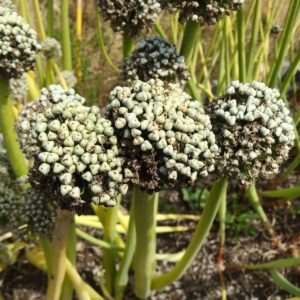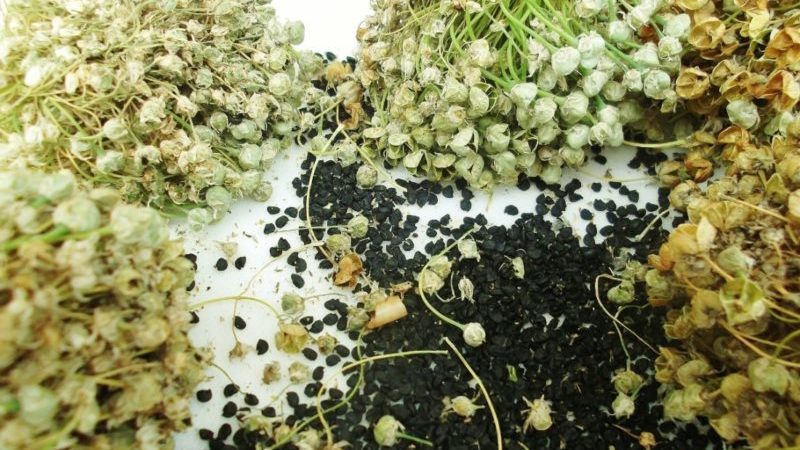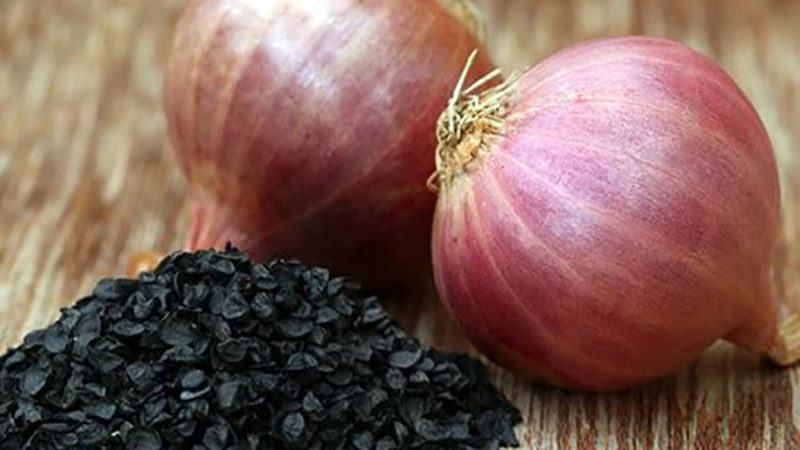Recommendations of experienced gardeners: is it possible to sow black onions before winter and when to do it
There are two ways to plant onions. It is grown from seed or seeds called nigella. If the markets sell mainly bulbs for sowing, then in specialized stores seeds of different varieties are available. To get a healthy planting material for the desired plant, it is better to use nigella.
Growing seed culture is complicated by the fact that turnips develop for two seasons. Winter sowing will help speed up the process. In this case, large vegetables will be ready for harvest in the fall. Is it possible to sow black onions before winter, how and when to do it, read on.
The content of the article
Advantages and disadvantages of winter sowing
Such cultivation chernushki has a number of advantages:
- If you plant seeds in the spring, then by autumn it will be possible to collect only the seedlings. In this case, you will have to wait another year before getting a full harvest. With podzimny sowing, large bulbs will appear next fall.

- The onion turns out to be stronger and more enduring, it suffers less from diseases. He manages to adapt to the composition of the soil and the climatic conditions of a particular region.
- The seeds, in contrast to the sevka, are small. Therefore, they do not have to free up and prepare a place in the basement or in the attic.
- In the spring, the soil will be moistened with melting snow and precipitation. The gardener does not have to waste time watering.
- Nigella germinates after the first warming. Sown before winter, it will grow much faster than crops planted at the usual time.
- In the spring, the gardener will not have to look for time to sow onions - it will be free to grow other crops.
- Most varieties of crops are suitable for sowing before winter.
The only drawback of this method is that the seeds are planted in frozen soil, so you have to work with cold soil, which is not always pleasant.
Receiving planting material
You don't have to buy nigella. Onion seeds are easy to get yourself. For this, the largest and healthiest turnips are selected from last year's harvest.
The selected material is planted in autumn or spring. In the middle of summer, the plants will throw out arrows. The inflorescences contain many dark brown or black seeds.
They ripen uncommonly. Therefore, after the appearance of the first black grains, the umbrellas are wrapped with gauze or a stocking so as not to lose part of the planting material. When the seeds are ripe, they are picked, laid out on paper and allowed to dry for several days.
Some vegetable growers use another method: they cut the umbrellas with still green seeds and leave them in the sun for 10-14 days. During this time, the material will fully mature.
Attention! To obtain planting material, the largest and healthiest turnips are used, which did not hurt during cultivation. Their seeds are distinguished by increased germination, high resistance to diseases and negative environmental factors.

Variety selection
Most crop varieties are suitable for planting late autumn and early winter. However, for the northern and central regions of Russia, it is better to choose winter-hardy plants.
| Variety | Short description |
| Agro Winter | The bulbs are round, large and juicy. On average, the weight of each specimen reaches 100 g. The top layer is white. |
| Siberian annual | Forms round-flattened turnips. The husk is yellow. Differs in an abundance of green mass. |
| Ruby | The bulbs are round. The weight of each varies within 55–85 g.Juicy purple scales, dry - with a silvery sheen. |
| Mouzon | Large round vegetables. The weight of each specimen is 100–120 g. The color of the top layer is white. |
| Buran | Large round bulbs weighing up to 100 g. The color of the husk is yellow. |
| Stuttgarter Riesen | Large flattened turnips. Each weight reaches 300 g. The taste is spicy. The husk is brown. |
| Luhansk | Large oval bulbs up to 145 g each. The husk is golden yellow. |
The described varieties are resistant to cold snaps, endure even the most frosty winters.
Sowing preparation
To grow strong and healthy onions, it is important to properly prepare the planting material. First, they are convinced of its germination:
- The seeds are sorted out and divided into groups by size. Large specimens germinate a week earlier than small ones.
- Several seeds from each batch are laid out on cheesecloth, which is covered with a saucer. It is moistened with water, covered with another layer of cloth and removed to a warm place. Moisten with warm liquid as it dries.
- When the seeds germinate, count the number of emerged specimens. If more than 30% has germinated, the batch is suitable for growing.
The rest of the seeds that did not germinate are prepared for winter planting.... For this:
- The seeds are immersed in water. An hour later, the specimens remaining on the surface are collected and soaked for another hour, the ones that have emerged are thrown away. Nigella, which sank to the bottom during the first and second soaking, is suitable for planting.
- The planting material is disinfected by soaking for 2 hours in a light pink solution of potassium permanganate.
- Nigella is immersed in water with a temperature of + 50 ° C for half an hour. After that, it is soaked for another 2 hours in aloe juice diluted with an equal amount of water.
- The prepared seeds are dried by spreading them in 1 layer in a warm place.
Do not dry Chernushka on the battery. Strong heat will cause the seeds to overheat and not germinate.
Landing dates

The timing depends on the region. Seeds are planted when the soil has already begun to freeze. This eliminates the risk of their germination ahead of time.
When to plant seeds by region:
- northern regions (Ural, Siberia) - late October - early November;
- central regions (Moscow region, Moscow) - mid - end of November;
- cities with a southern climate (Belgorod, Sochi) - December.
When choosing the time for winter sowing, they are not guided by generally accepted terms. It is important to look at the real weather this year. It is better to sow nigella later than before.
Attention! Some growers prefer to plant seeds in the snow.
Sowing rules
It's easy to grow nigella. It is important to follow the basic rules of planting and soil preparation. It depends on how high-quality and abundant the harvest will be and how many seeds will germinate.
Soil preparation
First of all, they choose a landing site. Garden plots on a small hill are best suited. This will help avoid stagnant moisture and reduce the risk of crop disease. It is important that the beds are well lit by the sun: the feathers of a plant in the shade will be yellow.
The beds on which onions previously grew are not used for planting the same culture for 2 years. Suitable predecessors are nightshade or legumes, cabbage, carrots.
Pre-prepare the soil. This is done in early October, when the soil is still soft enough:
- The earth is dug up, the remains of weeds and cultivated plants are removed.
- Fertilizers are applied: 0.5 buckets of humus or rotted manure and 1 tbsp are taken per 1 m2. ash.
- The soil is leveled with a rake, mixed with fertilizer.
- They form beds 15–20 cm high, make grooves 2 cm deep. A small amount of coarse table salt is poured onto the bottom to exclude onion fly infestation of plants.
If the soil is sufficiently nutritious, but heavy, river sand is taken instead of humus. Pour 1/3 of 10 liters of a bucket onto 1 m2.
Landing
Sowing nigella is easy. The main thing is to follow the rules:
- Grooves are made at a distance of 20 cm from each other. Their depth should be 2–2.5 cm.
- Seeds are poured into the grooves. Since the germination capacity of black cottages is low, they use a thickened planting. Up to 100 seeds are consumed per 1 m2.
- The seeds are sprinkled with a 2 cm layer of sand, then watered with warm settled water.
The beds are mulched with humus, peat, hay or sawdust to protect them from the cold. This is especially true for regions where little snow falls in winter.
Important! Seeds not older than 2 years are suitable for planting.
Further care
In autumn and winter, nigella is not watered, but they make sure that the beds are evenly covered with snow.

The main care is in the spring and summer. It includes the following stages:
- Thinning. Since nigella is sown quite densely, in spring the seedlings appear close to each other. To get large bulbs and a lot of greenery, thinning is carried out in 2 stages. When the seeds germinate, they leave 3 cm free between the plants. When 3-4 true leaves appear (this happens 2-3 weeks after the first shoots appear), thinning is carried out again, leaving 6-8 cm between the plants.
- Watering. Onions are watered twice a week in dry weather. With heavy precipitation, humidification is stopped. For 1 m2 spend up to 1 bucket of settled water at room temperature. Watering is stopped 2 weeks before harvesting.
- Loosening and weeding. After each moistening, the soil is loosened. This destroys the earth crust, which prevents root air exchange. At the same time, the beds are cleared of weeds: they spread diseases and cause shredding of the bulbs.
- Mulching. Mulch (sawdust, peat, hay or straw) protects plants from cold snaps, diseases, slows down the growth of weeds, prevents stagnation and evaporation of moisture, and the formation of an earthen crust. Such beds do not loosen.
Top dressing is applied three times per season, every 2-3 weeks:
- After the second thinning, organic nitrogen fertilizers are used. For example, a solution of mullein (1: 5) or chicken manure (1:10).
- For the second time, mineral compositions containing phosphorus and potassium are used.
- The third top dressing is made mineral-organic. In a bucket with a solution of chicken manure (1:10) add 20 g of superphosphate and 1 tbsp. ash.
Tips from experienced gardeners

To make the harvest more, and growing easier, use the advice of experienced gardeners:
- To make it easier to sow nigella and control the amount of seeds per 1 m2, planting material is mixed with chalk powder or light sand.
- Watering and feeding is carried out early in the morning or at sunset with low solar activity. This reduces the risk of plant burns.
- The day before feeding, the beds are watered abundantly so that the fertilizers do not harm the root system.
- Purchased planting material is disinfected and calibrated at the factory. This is evidenced by the inscriptions on the packaging. Such seeds are not disinfected at home, but they are still checked for germination.
- The yellowing and wilting of feathers indicate the readiness of the crop for harvest.
- If nigella is planted on greens, then spring thinning is done only 1 time.
For onions planted before winter, extreme warming is dangerous, followed by the onset of frost. If during the thaw the seeds have time to germinate, then with a sharp drop in temperature they will die.
Conclusion
Sowing nigella before winter is closest to the method of reproduction of onions in their natural environment. Therefore, this growing method is considered optimal. Plants planted in late autumn turn out to be more hardy, resistant to cold weather and disease. Wherein harvest large root crops are obtained in just 1 year.
When planting nigella in winter, it is important to follow the rules and sequence, choose the right time for garden work. Otherwise, the seeds will germinate ahead of time and die in frost.